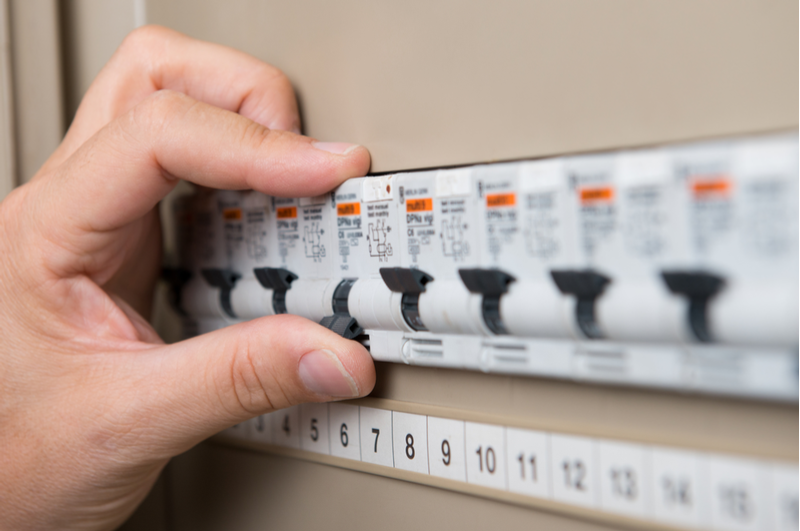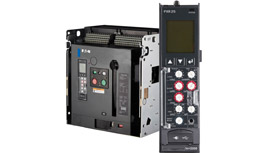CIRCUIT BREAKER ANALYZER
the instrument platform for circuit breaker maintenance, based on more than 20 years’ experience of over 4,000 delivered breaker analysers. The modular construction makes it possible to configure the TM1800 for measurements on all known types of circuit breakers in operation in today’s power world.
The robust design contains powerful technology that streamlines circuit breaker testing. Sophisticated measurement modules enable great time savings as many parameters can be measured simultaneously, eliminating the need for new setup each time.
testing using the DCM module makes the testing safe and time saving by keeping the circuit breaker grounded on both sides throughout the test. The DCM module uses a measuring technology called Dynamic Capacitive Measurement.

Circuit Breakers
circuit breaker infrastructure allows prevention of actions that can cause a node to go beyond its capacity or to go down. The premise of circuit breakers is to ensure a higher quality of service and only accept request loads that are serviceable in the current resource configuration.
When To Use Circuit Breakers
Circuit breakers should be used when the user wishes to trade request throughput for a higher Solr stability. If circuit breakers are enabled, requests may be rejected under the condition of high node duress with an appropriate HTTP error code (typically 503).
The “enabled” attribute controls the global activation/deactivation of circuit breakers. If this flag is disabled, all circuit breakers will be disabled globally. Per circuit breaker configurations are specified in their respective sections later. This attribute acts as the highest authority and global controller of circuit breakers. For using specific circuit breakers, each one needs to be individually enabled in addition to this flag being enabled.
circuit breaker tracks heap memory usage and rejects incoming search requests with a 503 error code if the heap usage exceeds a configured percentage of maximum heap allocated (-Xmx). The main configuration for this circuit breaker is controlling the threshold percentage at which the breaker will trip.
CPU Utilization Based Circuit Breaker
This circuit breaker tracks CPU utilization and triggers if the average CPU utilization over the last one minute exceeds a configurable threshold. Note that the value used in computation is over the last one minute — so a sudden spike in traffic that goes down might still cause the circuit breaker to trigger for a short while before it resolves and updates the value.

Circuit Breakers: A Handy Guide for Homeowners
The switches on your circuit breaker board have the main function of offering a safe way to turn your electrical power ON and OFF in specific areas of the house so that maintenance or repair work can be carried out safely by qualified electricians. It also serves the important secondary purpose of triggering the circuit breakers that cut the power when an electrical issue such as a short circuit or a ground fault occurs. When these issues occur, they force too much electricity to flow through a single circuit than it is designed to handle. A lightning strike, although unlikely, also has the potential to supply your household wiring with too much voltage which can also trigger a circuit breaker in your home. However, many electrical faults that take place are due to internal factors such as an overloaded circuit or simply a blown lightbulb.
If you find yourself in a situation where your home or commercial building appears powerless, or if certain appliances and/or sections of lighting suddenly cut out and leave you in the dark, then it is most likely that the primary safety feature on your circuit breaker board has triggered and has interrupted the flow of electrical current running through your wiring, appliances and electrical feeds. Without the breaker’s built-in defence mechanism working effectively, powerful currents can overheat, cause electrical damage and can even catch fire. Of course, this would not only result in the need to replace the ruined circuitry and home appliances (at high cost), but in a worst-case scenario can also pose a risk to life. Therefore, discovering the cause of a tripped circuit breaker in your home or commercial property is important to minimise risk must but be done in a safe manner.
An Overloaded Circuit – a circuit overload simply means that the electrical current running through a single circuit in your home or office is too high in voltage for what the circuit was designed to carry. For example; overloading a single plug socket with a number of extension leads and multiple electrical appliances at the same time. The issue is also more likely to occur if the appliances plugged in collectively require a lot of power. If your circuit breaker has kicked in then this is a good sign, it’s doing its job of preventing electrical hazards from causing risk. You can resolve this type of issue by separating your electrical appliances across various plug sockets rather than running multiple appliances on one circuit. This will reduce the level of voltage to a safer and more manageable quantity for your wiring and electrical outputs.
A Short Circuit – short-circuiting comes as a result of incorrect wiring or faulty appliances, switches, plugs, receptacles or cords in your home or office that much like an overloaded circuit, will result in too strong of an electrical current for one single circuit to handle. It takes place due to the active (hot) wire coming into contact with either the neutral wire and/or another hot wire. When this happens, the electrical charge of each wire combines and causes an unsafe level of voltage that exceeds the circuits load capabilities. A sign of short-circuiting occurring is if the circuit breakers kick in continuously in the same area of the property. Also, if you notice a faint burning smell deriving from any electrical output then it is important to get in touch with a certified electrician immediately and definitely not to attempt to do anything about it yourself. In doing so they can then solve your electrical issue safely and can prevent a potentially harmful electrical hazard from taking place.
A Ground Fault – ground faults are similar to short circuits although differ as they occur when the active (hot) wire comes into contact with the walls of the protective metal box or a ground wire. This electrical hazard is particularly dangerous in areas of moisture such as bathrooms, kitchens or external outputs and so it is stated by the National Authority that homes should be fitted with Ground Fault Circuit Interrupters (GFCI) and should be used in conjunction with safety switches and outlets. If you discover a ground fault in your home then it is crucially important to have a certified electrician to come and assess this type of issue as it can easily cause electric shocks, electrocution (especially in damp areas), and can even start fires. Ground faults aren’t the easiest electrical fault to find symptoms for, but if you experience things such as; a small electric shock when you touch a metal surface, if your TV/computer screen displays strobing lines, if you hear a humming/buzzing noise from your TV or stereo set, or if your GFCI trips frequently, then these are all signs that you need to call for professional help to resolve the issue properly as soon as possible.
Air Circuit Breakers
Modern systems for low-voltage energy distribution, particularly those for regenerative applications, are more compact yet make higher demands on the integrated components.
meets these increased demands with new materials and a modified construction. Two compact sizes facilitate smaller switch panels. The modular design and common range of accessories allow simple integration. ‘Series NRX’ offers a high degree of functionality and
Advantages:
Modern circuit-breaker technology reduces system costs
The high-end multi-functional control unit (P type) with large colour graphic display facilitates all well-known applications
Modbus, Profibus, Ethernet and INCOM compatible
Engineering design simplified by reduction to just 2 sizes
Flexible and easy connection using the rotating connection adapter and associated connection options
Main applications:
System protection
Motor protection
Transformer protection
Generator protection
With the selection of the appropriate control unit, the switches are optimised for these applications and include comprehensive additional functions as standard or as options.
A Quick Guide: UL 489 or UL 1077
A common question that comes up with OEM machine builders and control panel builders is “How do I know when to use UL 1077 or UL 489 breakers in panels or equipment?” The answer is seemingly simple, but like most simple questions, there is usually some confusion. No one wants to be the only person in the room who puts up their hand and asks a question to which they believe “everyone else” knows the answer.
How do you assure that you meet the required standards? The following information should give you a better understanding of the standards that must be met — and how to meet those standards. The function of a circuit breaker is to provide overload (thermal) and short-circuit (magnetic) protection to a circuit and its downstream components. A circuit breaker functions like an airbag in a car, protecting circuit components and people by tripping the circuit to interrupt the current flow if it detects a fault condition in the control system.
What are UL 489 and UL 1077?
UL 489 Circuit Breakers
UL 489 circuit breakers are “intended for installation in a circuit breaker enclosure or as parts of other devices, such as service entrance equipment and panelboards.” They are regularly required on panel designs, per the National Electrical Code.
UL 1077 Supplementary Protectors
UL 1077 defines supplementary protectors as devices intended for use as overcurrent, over-voltage or under-voltage protection within an appliance or other electrical equipment where branch-circuit overvoltage protection is already provided or is not required.
UL Standards Comparison – UL 489 vs UL 1077
Under the UL services, low-voltage air circuit breakers, molded-case circuit breakers, and miniature circuit breakers are evaluated and “Listed” to UL 489 for use as a standalone product. By contrast, “Recognized” devices under UL 1077, Supplementary Protectors for Use in Electrical Equipment, are evaluated only for use as components in “Listed” products. In contrast to “Listed” circuit breakers, UL 1077 supplementary protectors are “Recognized” components. This means that they are investigated for factory installation in “Listed” products, such as a UL 508a panel.
Both UL 489 and UL 1077 devices must pass a series of calibration, overload, endurance and short-circuit tests. The UL 489 and UL 1077 Standards testing are similar, but the UL 489 testing is more rigorous. Unlike UL 489, a UL 1077 circuit protection device does not necessarily need to survive the test. See Figure 1, below, for a comparison of the testing.